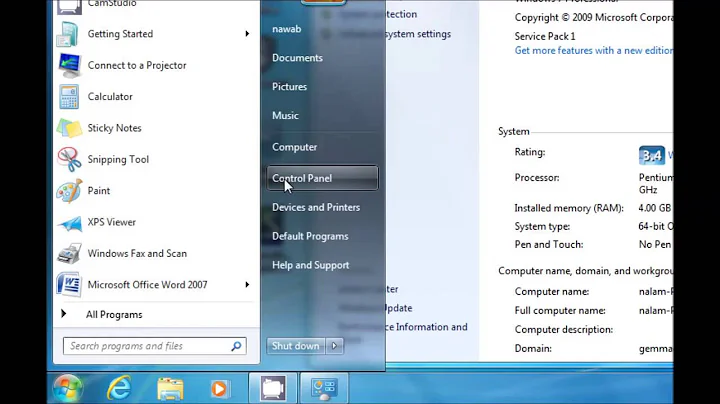User-account missing from "Manage Accounts" in windows-7 64bit
Solution 1
I just had the same issue on a Windows 7 Pro x64 box, and never had any issues on Windows 7 Ultimate x86/32bit version.
I will assume that it might be a 7 Pro issue, or bad port on Microsoft's part to x64 (or a bad software combo on a Lenovo due to all the tweaks they do with all the goofy bloatware software preinstalled.
I restored from scratch, did all updates, installed office, did all updates, set Admin passwd, enabled Admin account, rebooted. User wasn't available, but I used that user to do ALL UPDATES AND INSTALL ALL SOFTWARE. User was able to be seen in Computer Management, and not disabled account, yet could not see the user during logon, nor in CTRL PANEL in users.
Deleted the account through Comp. manage and recreated, and all is well (after deleteing the profile as well)...
Solution 2
I just had similar problem - I created new user (using Manage Computer, Local Users and Groups) and this user is not visible in login screen nor Manage Accounts.
So I noticed that user belongs only "Homeuser" group and NOT to Users group. So I add it to Users group and all works now, user is visible in login screen and Manage Accounts.
Solution 3
Is there a way to either control the state of an account and enable/disable it without using "Local Users and Groups" or if not is there a way hack windows to enable "Local Users and Groups"?
yes, you can enable/disable a user account through the Windows registry, as described in this tutorial:
How to Hide or Unhide a User Account in Vista (works in Windows 7)
see Method #2
Solution 4
I believe I may have an easier answer, providing you know the name of the "missing" account.
You can also do the following from a command prompt (Start → Run → cmd) in Windows 7 Home Premium:
net user "someone" /active:yes
To disable an account without deleting it (will also hide the account from the control panel UI) you can likewise do this:
net user "someone" /active:no
Related videos on Youtube
vrutberg
Updated on September 17, 2022Comments
-
vrutberg over 1 year
I am pretty new to this whole servlet thing, so please correct me if I mix or use incorrect/confusing terms for things. I am however writing a blog ping server in Java using JAX-RS (Jersey), and I'm facing a problem where I have one servlet class that accepts REST input, and another servlet class that lists the same content.
Right now they are sharing their objects through a class that looks like this:
public class BlogPingUtils { private static final String LIST_OF_CHANGES = "listOfChanges"; public static List<PingInfo> getListOfChanges(ServletContext context) { List<PingInfo> listOfChanges = (List<PingInfo>)context.getAttribute(LIST_OF_CHANGES); if(listOfChanges == null) listOfChanges = new ArrayList<PingInfo>(); return listOfChanges; } public static void setListOfChanges(ServletContext context, List<PingInfo> listOfChanges) { context.setAttribute(LIST_OF_CHANGES, listOfChanges); } }This works in a small-scale development environment, but it feels dirty and probably wouldn't work in a heavy-duty production environment because of concurrency issues and such. Also it's not very flexible. What I would like to do is have an interface that would have methods for reading and writing data. Then I would inject an object of a class that implements this interface into these two servlets, so that they are actually using the same object for interacting with the data. This would then be backed by a synchronized list or database transactions or something.
What would be the preferred way to do this? Is it possible? My web.xml is very simple right now and looks like this:
<?xml version="1.0" encoding="UTF-8"?> <web-app xmlns="http://java.sun.com/xml/ns/j2ee" xmlns:xsi="http://www.w3.org/2001/XMLSchema-instance" xsi:schemaLocation="http://java.sun.com/xml/ns/j2ee http://java.sun.com/xml/ns/j2ee/web-app_2_4.xsd" version="2.4"> <display-name>Blog Ping</display-name> <servlet> <servlet-name>Jersey REST Service</servlet-name> <servlet-class>com.sun.jersey.spi.container.servlet.ServletContainer</servlet-class> <init-param> <param-name>com.sun.jersey.config.property.packages</param-name> <param-value>com.vrutberg.blogping</param-value> </init-param> <load-on-startup>1</load-on-startup> </servlet> <servlet-mapping> <servlet-name>Jersey REST Service</servlet-name> <url-pattern>/*</url-pattern> </servlet-mapping> </web-app>-
alex over 14 yearsIt would be better to add comments to the answers provided instead of editing your original question. Edits should be made when you have something important to change.
-
-
Skadlig almost 13 yearsInterresting suggestion but it unfortunatly didn't work.
-
Skadlig about 12 yearsI have since I wrote my question reinstalled my installation. I will accept your answer though since I'm pretty certain that it would work. Even if it's a bit more heavy handed than I would have liked.
-
vrutberg about 12 yearsYes, that is something what I had in mind. Can you show an example of how to do that with JNDI? Using Google right now to try to find one... :)
-
vrutberg about 12 yearsAlso, I found this: jersey.java.net/nonav/documentation/latest/… Can I use this to work around the need of a singleton?
-
Bruno Grieder about 12 yearsI would avoid using Jersey only solutions; you may always need the resources from the central repository in another artefact, say a standard servlet. If you are sure you will only do Jersey/JAX-RX, why not. For JNDI, it depends on your servlet container. If you use Jetty, you have to enable it: check here: link. For Tomcat it is already 'there', check the Tomcat global JNDI how to
-
vrutberg about 12 yearsI think I will be switching approach to including Spring in my project, and use that to accomplish this instead. Thanks for your help!




